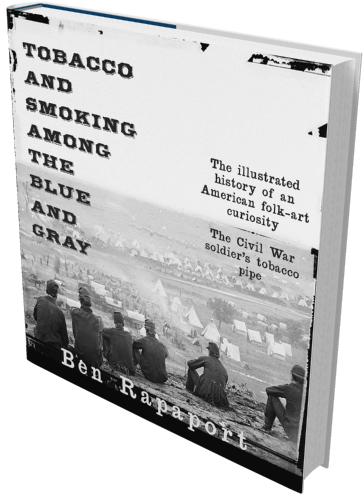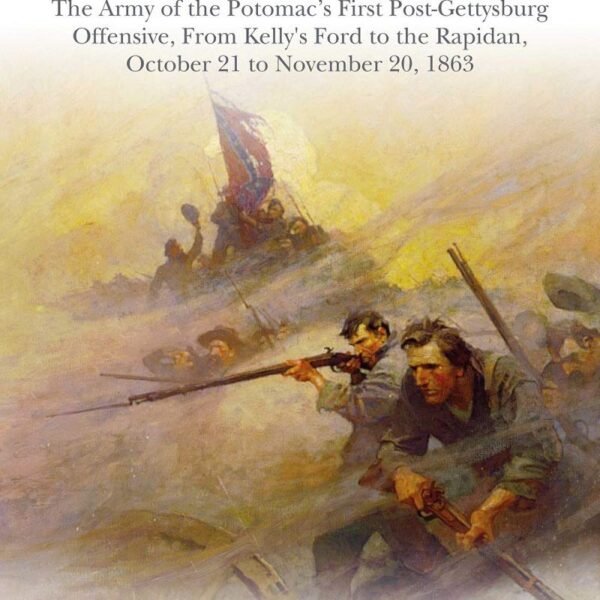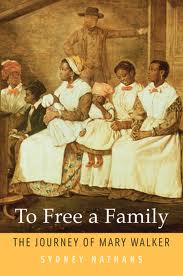Tobacco and Smoking Among the Blue and Gray: The Illustrated History of An American Folk-Art Curiosity—The Civil War Soldier’s Tobacco Pipe by Ben Rapaport. Briar Books Press, 2014. Cloth, $65.00.

The American Civil War has inspired an incredible amount of writing. For some, this is a source of annoyance. Do we really need a three-volume history of the Battle of Gettysburg, the naysayers cry, or detailed biographies of low-ranking, second-rate officers in the Army of the Cumberland? Perhaps not. But for many readers, the sheer volume of writing on the war is a source of attraction—a reminder of just how rich, vast, and varied even a small sliver of the human past can be.
Those in the latter camp will no doubt find much to enjoy in Ben Rapaport’s Tobacco and Smoking Among the Blue and Gray, the first book to date on pipe-carving and tobacco-smoking among the Union and Confederate armies (and among the first crop of publications from Briar Books Press, the pipeman’s premier publisher). Penned by a prolific authority on the material culture of tobacco use, Tobacco and Smoking surveys the finest examples of Civil War-era briarwood pipes—the majority produced by untrained amateurs in the Union and Confederate armies—as well as the social and cultural context of pipe smoking among Civil War-era soldiers.
The book will be of interest to both collectors of Civil War memorabilia and scholars of the period. For the former, the book boasts hundreds of images of period pipes from the collections of Norm Flayderman and Jan Sorgenfrei—now departed, but previously the United States’ leading collectors of Civil War-era tobacciana. Just as importantly, Tobacco and Smoking includes tips on how to incorporate period-appropriate, hand-carved pipe reproductions in the reenactor’s kit, and whether to invest in antique pipes—among the hottest tickets in Civil War memorabilia today, where choice pieces are regularly fetching upwards of $2,000.
For more scholarly-minded students of the conflict, the book offers intriguing chapters on tobacco use in the ranks and pipe-making materials and methods, as well as more wide-ranging reflections on the intimate relationship between tobacco and organized violence in modern history. The latter subject Rapaport handles deftly, as he addresses the various purposes the wicked weed serves in times of war: from masking the smells of human waste, body odor, and decomposition, to fighting hunger, calming nerves, and boosting under-rested soldiers’ energies. Perhaps most impressively, Rapaport manages to evoke—in a way that only past or present smokers will understand—how tobacco simultaneously lends poetry to solitude, warmth to companionship, and wild, pathetic desperation to withdrawal. Thus, cheek by jowl with touching scenes of men mingling smoke after an ugly day’s fighting, we find dismal stories of Andersonville prisoners swapping their scarce allotment of bread for rotten tobacco or plucking discarded chaw from the spittle-strewn earth to satisfy their jones. Tobacco, it seems, made life easier for Civil War soldiers—until it didn’t.
But no doubt the most intriguing feature of Tobacco and Smoking is what the book doesn’t say. Omitting any sustained analysis of the surveyed pipes, Rapaport leaves it to the reader to plug these artifacts into existing historiographical conversations. The most obvious of these is the ongoing debate regarding Civil War soldiers’ reasons for fighting, which would almost certainly be enriched by considering pipes as a primary source. Painstakingly carved over lengthy periods of time—and ostensibly reflective, not just of pipe-decorating tropes, but of their creators’ beliefs and convictions—the pipes’ iconography offers viewers untapped insights into soldiers’ motivations. What, then, do these pipes say about the people who made them? Overrun with eagles, Old Glories, Lady Liberties, and Union slogans—and conspicuously absent any reference to slavery or emancipation—the Yankee-made pipes (which constitute the majority of Rapaport’s survey) tend to confirm Gary W. Gallagher’s argument in The Union War that, for white Northerners, the war began and ended as a fight for Union. Whether this inference is simply a distortion of Rapaport’s sample remains for another historian to decide.
Taken as a whole, Tobacco and Smoking will gratify readers who enjoy an unexpected approach to a familiar topic and frustrate those who prefer scholarly and historiographical rigor. Rapaport, after all, is not a professional historian, nor does he pretend to be. Despite an encyclopedic knowledge of pipes and some impressive research on the history of tobacco use in the mid-nineteenth century, Rapaport nevertheless cites a number of questionable sources—including Wikipedia—and cleaves to several outdated interpretations of the war. Slavery is scarcely mentioned in the pages of Tobacco and Smoking, and the portrait of the conflict that emerges from the book bears a markedly reconciliationist hue. Indeed, by Rapaport’s reckoning, the men who carved the war’s pipes were manly and valorous ones with nary a political thought in their heads: content to prove their bravery by day and smoke away their troubles by night.
But, despite these shortcomings, pipe historian Ben Rapaport achieves two impressive feats in Tobacco and Smoking Among the Blue and Gray. He writes a better book than most Civil War historians could write about pipes. And he invites readers to reconsider a familiar episode in American history from a provocative and fruitful perspective. Never again will I overlook the omnipresent pipes and tobacco paraphernalia in Civil War-era imagery—or forget soldiers’ loving, compulsive, perverse devotion to the murky enemy in their midst.
Sean Trainor is the Digital Pedagogy Content Designer for the Richards Civil War Era Center’s People’s Contest Digital Archiving Project at the Pennsylvania State University. He also teaches history and humanities at Santa Fe College in Gainesville, Florida.




